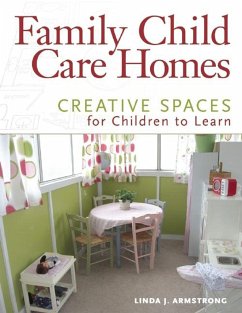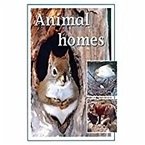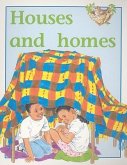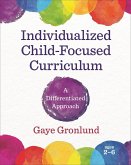- Broschiertes Buch
- Merkliste
- Auf die Merkliste
- Bewerten Bewerten
- Teilen
- Produkt teilen
- Produkterinnerung
- Produkterinnerung
Create inspiring, comfortable learning environments for children that capture the feeling of home in family child care settings.
Andere Kunden interessierten sich auch für
![Animal Homes Animal Homes]() RigbyAnimal Homes16,99 €
RigbyAnimal Homes16,99 €![Houses and Homes Houses and Homes]() RigbyHouses and Homes16,99 €
RigbyHouses and Homes16,99 €![Education and Child Welfare System Efforts to Improve Educational Outcomes for Youth in Foster Care Education and Child Welfare System Efforts to Improve Educational Outcomes for Youth in Foster Care]() Susan Bush-MecenasEducation and Child Welfare System Efforts to Improve Educational Outcomes for Youth in Foster Care19,99 €
Susan Bush-MecenasEducation and Child Welfare System Efforts to Improve Educational Outcomes for Youth in Foster Care19,99 €![Individualized Child-Focused Curriculum Individualized Child-Focused Curriculum]() Gaye GronlundIndividualized Child-Focused Curriculum35,99 €
Gaye GronlundIndividualized Child-Focused Curriculum35,99 €![Chronicles of the Schonberg Cotta Family Chronicles of the Schonberg Cotta Family]() Elizabeth Rundle CharlesChronicles of the Schonberg Cotta Family25,99 €
Elizabeth Rundle CharlesChronicles of the Schonberg Cotta Family25,99 €![Children Under the Poor Law: Their Education, Training and After Care Children Under the Poor Law: Their Education, Training and After Care]() William ChanceChildren Under the Poor Law: Their Education, Training and After Care25,99 €
William ChanceChildren Under the Poor Law: Their Education, Training and After Care25,99 €![The Irish Twins The Irish Twins]() Lucy Fitch PerkinsThe Irish Twins18,99 €
Lucy Fitch PerkinsThe Irish Twins18,99 €-
-
-
Create inspiring, comfortable learning environments for children that capture the feeling of home in family child care settings.
Produktdetails
- Produktdetails
- Verlag: Redleaf Press
- Seitenzahl: 240
- Erscheinungstermin: 16. August 2011
- Englisch
- Abmessung: 259mm x 201mm x 13mm
- Gewicht: 703g
- ISBN-13: 9781605540757
- ISBN-10: 1605540757
- Artikelnr.: 32421425
- Herstellerkennzeichnung
- Libri GmbH
- Europaallee 1
- 36244 Bad Hersfeld
- gpsr@libri.de
- Verlag: Redleaf Press
- Seitenzahl: 240
- Erscheinungstermin: 16. August 2011
- Englisch
- Abmessung: 259mm x 201mm x 13mm
- Gewicht: 703g
- ISBN-13: 9781605540757
- ISBN-10: 1605540757
- Artikelnr.: 32421425
- Herstellerkennzeichnung
- Libri GmbH
- Europaallee 1
- 36244 Bad Hersfeld
- gpsr@libri.de
Linda J. Armstrong: Linda J. Armstrong is a consultant for children and youth programs throughout the United States. As an active member of non-profit organizations, she has served in a variety of leadership positions for more than thirty years. Linda is a published author of educational research and has been an adjunct professor for universities in the U.S. and New Zealand. She holds three degrees in education and has received numerous awards and recognition for her work.
Introduction
Chapter 1: Making Room For Children and For Your Family
Creating an Environment that Meets the Needs of Your Family
Understanding Health and Safety Guidelines for Your Family Child Care
Environment
Setting Goals for Your Children and Your Program
Selecting Family Child Care Spaces
If You Are New to Family Child Care
Chapter 2: The "Wow" Factor
Colors and Patterns
Natural Materials
The Right Light (Selecting appropriate lighting sources and locations)
Walls and Halls (displays of children's work, regulations, labeling)
If You Are New to Family Child Care
Chapter 3: Putting the "Oh" in Organization
Decluttering
Stow, Store, or Throw
Rotating Materials
If You Are New to Family Child Care
Chapter 4: Putting the "Home" Back in Home Child Care
Room Arrangements
Interest Areas Vs. Interest Centers
Design Elements for Child Care Spaces
Selecting Floors, Furniture, and Fun Stuff
Universal Design (ADA codes and guidance)
If You Are New to Family Child Care
Chapter 5: Backyard Environments
Outdoor Play Areas (CPSC and ASTM guidance, applicable ADA requirements)
If You Are New to Family Child Care
Appendix
Materials Inventory Sheets
Time and Use Inventories
Goals Worksheet
Places and Spaces Design Paper
Warning Signs the Environment Isn't Working
ADA Guidelines for Child Care Programs
Guidelines for Purchasing Safe Toys and Outdoor Play Structures
Top Ten Ways to Develop Quality Environments
Homestyle Places & Spaces Design Worksheet
Chapter 1: Making Room For Children and For Your Family
Creating an Environment that Meets the Needs of Your Family
Understanding Health and Safety Guidelines for Your Family Child Care
Environment
Setting Goals for Your Children and Your Program
Selecting Family Child Care Spaces
If You Are New to Family Child Care
Chapter 2: The "Wow" Factor
Colors and Patterns
Natural Materials
The Right Light (Selecting appropriate lighting sources and locations)
Walls and Halls (displays of children's work, regulations, labeling)
If You Are New to Family Child Care
Chapter 3: Putting the "Oh" in Organization
Decluttering
Stow, Store, or Throw
Rotating Materials
If You Are New to Family Child Care
Chapter 4: Putting the "Home" Back in Home Child Care
Room Arrangements
Interest Areas Vs. Interest Centers
Design Elements for Child Care Spaces
Selecting Floors, Furniture, and Fun Stuff
Universal Design (ADA codes and guidance)
If You Are New to Family Child Care
Chapter 5: Backyard Environments
Outdoor Play Areas (CPSC and ASTM guidance, applicable ADA requirements)
If You Are New to Family Child Care
Appendix
Materials Inventory Sheets
Time and Use Inventories
Goals Worksheet
Places and Spaces Design Paper
Warning Signs the Environment Isn't Working
ADA Guidelines for Child Care Programs
Guidelines for Purchasing Safe Toys and Outdoor Play Structures
Top Ten Ways to Develop Quality Environments
Homestyle Places & Spaces Design Worksheet
Introduction
Chapter 1: Making Room For Children and For Your Family
Creating an Environment that Meets the Needs of Your Family
Understanding Health and Safety Guidelines for Your Family Child Care
Environment
Setting Goals for Your Children and Your Program
Selecting Family Child Care Spaces
If You Are New to Family Child Care
Chapter 2: The "Wow" Factor
Colors and Patterns
Natural Materials
The Right Light (Selecting appropriate lighting sources and locations)
Walls and Halls (displays of children's work, regulations, labeling)
If You Are New to Family Child Care
Chapter 3: Putting the "Oh" in Organization
Decluttering
Stow, Store, or Throw
Rotating Materials
If You Are New to Family Child Care
Chapter 4: Putting the "Home" Back in Home Child Care
Room Arrangements
Interest Areas Vs. Interest Centers
Design Elements for Child Care Spaces
Selecting Floors, Furniture, and Fun Stuff
Universal Design (ADA codes and guidance)
If You Are New to Family Child Care
Chapter 5: Backyard Environments
Outdoor Play Areas (CPSC and ASTM guidance, applicable ADA requirements)
If You Are New to Family Child Care
Appendix
Materials Inventory Sheets
Time and Use Inventories
Goals Worksheet
Places and Spaces Design Paper
Warning Signs the Environment Isn't Working
ADA Guidelines for Child Care Programs
Guidelines for Purchasing Safe Toys and Outdoor Play Structures
Top Ten Ways to Develop Quality Environments
Homestyle Places & Spaces Design Worksheet
Chapter 1: Making Room For Children and For Your Family
Creating an Environment that Meets the Needs of Your Family
Understanding Health and Safety Guidelines for Your Family Child Care
Environment
Setting Goals for Your Children and Your Program
Selecting Family Child Care Spaces
If You Are New to Family Child Care
Chapter 2: The "Wow" Factor
Colors and Patterns
Natural Materials
The Right Light (Selecting appropriate lighting sources and locations)
Walls and Halls (displays of children's work, regulations, labeling)
If You Are New to Family Child Care
Chapter 3: Putting the "Oh" in Organization
Decluttering
Stow, Store, or Throw
Rotating Materials
If You Are New to Family Child Care
Chapter 4: Putting the "Home" Back in Home Child Care
Room Arrangements
Interest Areas Vs. Interest Centers
Design Elements for Child Care Spaces
Selecting Floors, Furniture, and Fun Stuff
Universal Design (ADA codes and guidance)
If You Are New to Family Child Care
Chapter 5: Backyard Environments
Outdoor Play Areas (CPSC and ASTM guidance, applicable ADA requirements)
If You Are New to Family Child Care
Appendix
Materials Inventory Sheets
Time and Use Inventories
Goals Worksheet
Places and Spaces Design Paper
Warning Signs the Environment Isn't Working
ADA Guidelines for Child Care Programs
Guidelines for Purchasing Safe Toys and Outdoor Play Structures
Top Ten Ways to Develop Quality Environments
Homestyle Places & Spaces Design Worksheet








